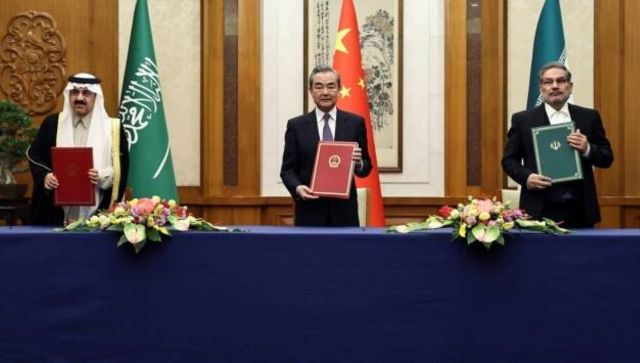Early last month, the announcement that Saudi Arabia and Iran are normalising their relationship due to a peace deal brokered by China took many by surprise. After all, this agreement wasn’t only paving way for interesting new alignments in a divided region, but it was also making a point that can’t be stressed enough — China has arrived as a global actor and its role in shaping the world order is only going to become prominent. This achievement of China comes early in the third and unprecedented term for President Xi Jinping who kickstarted his term with a visit to Saudi Arabia and by hosting the Iranian President in Beijing.
The optics of the peace deal definitely played out with Chinese Foreign Minister Wang Yi standing in the middle flanked by Iranian and Saudi leaders on either side — all locked in a ceremonial handshake. What’s more noteworthy is that such moments are only going to become more frequent with a growing Chinese interest in securing a global role for itself. In the region of West Asia, China is simply occupying a space from which the US is retreating. In the last few years, a perception has emerged that the US is withdrawing from West Asia (what it refers to as the Middle East). This is despite the fact that the US still continues to have a considerable military presence in the region. However, the Pivot to Asia strategy in the beginning of last decade and shift in the US’ strategic focus to the Indo-Pacific has created an image of a retreating US from West Asia. This has been accompanied by China which is looking to engage more and more with the outside world due to its own economic and energy needs.
While the peace deal between Saudi Arabia and Iran has come as an important juncture, one must not miss the Chinese involvement in West Asia which has been going on for many years in the background. China’s engagement in the region is driven by the two big Es — Energy and Economy. China’s stupendous economic growth has positioned it as the largest customer of energy in the world with 67 percent of its fuel requirement being met through imports. Out of this, more than 40 percent of its energy needs are fulfilled by GCC countries. While China’s energy requirements are only going to increase its dependence on West Asia, the countries in this region are also looking for new countries to buy their oil. One of their major former buyers, the US has now turned into a net exporter of natural gas. As a result, its dependence on West Asia has come down. In 2023, the US emerged as the world’s largest exporter of LNG dethroning Australia and leaving behind Qatar in the race.
China has also occupied the status of the largest trade partner for the countries in the West Asian region. It has emerged as their biggest exporter by overtaking the US in 2008 and the European Union in 2020. Its exports to the region stood at $129 billion in 2021 while in comparison the US’ exports were just a fraction of the same at $48 billion. It is also negotiating a free trade agreement with the GCC countries, a protracted process that has now been fast-tracked.
Impact Shorts
More ShortsInterestingly, many of the regional countries have been long dependent on oil for their economic growth. But they are now looking to make a shift away from oil due to their fast-depleting oil reserves, climate-change concerns and a preference for clean energy world over. It is for this reason that they have launched vision strategies to diversify their economies beyond oil. China finds a place in all these diversification plans including in Saudi Arabia’s 2030 Vision and Kuwait’s 2035 Vision. There is a key focus on maritime, infrastructure and high-end technology cooperation between the two. While China’s 5G technology hasn’t found any takers in countries such as the US, Australia, India and Vietnam, it has been welcomed by Saudi Arabia and the UAE. All this is taking place along with China’s deeper inroads in the region through its Belt & Road Initiative.
Now what does China’s increased engagement with the region mean in geopolitical terms? Especially in view of the fact that China is also cooperating with the countries in the region in the military domain: It is helping Saudi Arabia produce ballistic missiles as per intelligence reports. There are also reports of a secret Chinese port project near Abu Dhabi, the UAE’s capital. China’s successful mediation between Iran and Saudi Arabia has also taken some shine off the Abraham Accords, brokered by the US between Israel and different Arab states. China’s increased interest in the region is now taking a strategic shape, away from its mere dependence on the region for oil. But one sigh of relief is that it is still not interested in becoming a security guarantor in the region, a la the United States, and that means the window of strategic cooperation for other players in the region is still open.
The author is a PhD in International Relations from the Department of International Relations, South Asian University. Her research focuses on the political economy of South Asia and regional integration. Views expressed are personal.
Read all the Latest News , Trending News , Cricket News , Bollywood News , India News and Entertainment News here. Follow us on Facebook, Twitter and Instagram.


)

)
)
)
)
)
)
)
)



